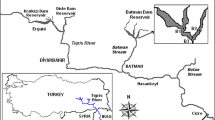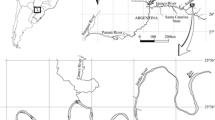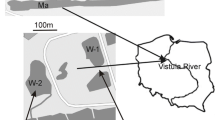Abstract
The effect of controlled flushing on natural phytoplankton communities in brackish estuarine water ponds of Doñana Natural Park (Guadalquivir marshes, SW Spain) was evaluated throughout a year cycle by 16S chloroplast rDNA metagenome analysis. Multivariate analysis of phytoplankton assemblages based on the abundance of 30 main identified microalgae included in seven different phyla revealed pond flushing accounted for 19.6% of total data variation, a value far below the 42.5% variability explained by seasonality. Microalgae species biovolume was a better descriptor explaining phytoplankton assemblages in comparison to species relative abundance. Increasing pond flushing led to augmented phytoplankton diversity in spring, summer and autumn, but not in winter. Diatoms were more abundant under high water flushing, a situation that favoured the tychopelagic behaviour of some species. Cyanobacteria and dinophytes were more abundant under low flushing. Haptophytes and cryptophytes relative biomass was also enhanced by low water flushing, but only during winter and spring. Two main haptophytes that seasonally succeeded each other exhibited opposed response to hydrology with Isochrysis sp. showing negative response to increased flushing and Diacronema vlkianum showing a positive reaction. Both species represented a permanent and relevant haptophytes contribution to phytoplankton assemblages in marsh ponds previously undescribed in the area.






Similar content being viewed by others
References
Abid, O., A. Sellami-Kammoun, H. Ayadi, Z. Drira, A. Bouaïn & L. Aleya, 2008. Biochemical adaptation of phytoplankton to salinity and nutrient gradients in a coastal solar saltern, Tunisia. Estuarine, Coastal and Shelf Science 80: 391–400.
Adam, P., 1990. Saltmarsh Ecology. Cambridge University Press, Cambridge, UK.
Anderson, M. J., 2001. A new method for non-parametric multivariate analysis of variance. Austral Ecology 26: 32–46.
Armada, I., I. Hachero-Cruzado, N. Mazuelos, J. L. Ríos, M. Manchado & J. P. Cañavate, 2013. Differences in betaine lipids and fatty acids between Pseudoisochrysis paradoxa VLP and Diacronema vlkianum VLP isolates (Haptophyta). Phytochemistry 95: 224–233.
Behrenfeld, M. J. & E. S. Boss, 2014. Resurrecting the ecological underpinnings of ocean plankton blooms. Annual Review of Marine Science 6: 167–194.
Bendif, E. M., I. Probert, D. C. Schroeder & C. Vargas, 2013. On the description of Tisochrysis lutea gen. nov. sp. nov. and Isochrysis nuda sp. nov. in the Isochrysidales, and the transfer of Dicrateria to the Prymnesiales (Haptophyta). Journal of Applied Phycology 25: 1763–1776.
Brett, M. T. & D. C. Müller-Navarra, 1997. The role of highly unsaturated fatty acids in aquatic food web processes. Freshwater Biology 38: 483–499.
Brown, M. R., S. W. Jeffrey, J. K. Volkman & G. A. Dunstan, 1997. Nutritional properties of microalgae for mariculture. Aquaculture 151: 315–331.
Chícharo, M. A., L. Chícharo & P. Morais, 2006. Inter-annual differences of ichthyofauna structure of the Guadiana estuary and adjacent coastal area (SE Portugal/SW spain): before and after Alqueva dam construction. Estuarine, Coastal and Shelf Science 70: 39–51.
Clarke, K. R., 1993. Non-parametric multivariate analyses of changes in community structure. Austral Journal of Ecology 18: 117–143.
Costa, L. S., V. L. M. Huszar & A. R. Ovalle, 2009. Phytoplankton functional groups in a tropical estuary: Hydrological control and nutrient limitation. Estuarine, Coastal and Shelf Science 32: 508–521.
Cuvelier, M. L., A. E. Allen, A. Monier, J. P. McCrow, M. Messié, S. G. Tringe, T. Woyke, R. M. Welsh, T. Ishoey, J. H. Lee, B. J. Binder, C. L. DuPont, M. Latasa, C. Guigand, K. R. Buck, J. Hilton, M. Thiagarajan, E. Caler, B. Read, R. S. Lasken, F. P. Chavez & A. Z. Worden, 2010. Targeted metagenomics and ecology of globally important uncultured eukaryotic phytoplankton. Proceedings of the Natural Academy of Science USA 107: 14679–14684.
Dahl, E., E. Bagoien, B. Edvardsen & N. C. Stenseth, 2005. The dynamics of Chrysochromulina species in the Skagerrak in relation to environmental conditions. Journal of Plankton Research 54: 15–24.
Danielsdottir, M. G., M. T. Brett & G. B. Arhonditsis, 2007. Phytoplankton food quality control of planktonic food web processes. Hydrobiologia 589: 29–41.
Díez-Minguito, M. A., M. Baquerizo, M. Ortega-Sánchez, G. Navarro & M. A. Losada, 2012. Tide transformation in the Guadalquivir estuary (SW Spain) and process-based zonation. Journal of Geophysical Research 117: C03019.
Domingues, R. B., A. B. Barbosa & H. M. Galvão, 2014. River damming leads to decreased phytoplankton biomass and disappearance of cyanobacteria blooms. Estuarine, Coastal and Shelf Science 136: 129–138.
Downing, A. L. & M. A. Leibold, 2002. Ecosystem consequences of species richness and composition in pond food webs. Nature 416: 837–841.
Dubois, M., K. A. Gilles, J. K. Hamilton, P. Rebers & F. Smith, 1956. Colorimetric method for determination of sugars and related substances. Analytical Chemistry 28: 350–356.
Durmaz, Y., M. Donato, M. Monteiro, L. Gouveia, M. L. Nunes, T. Gama Pereira, S. Gökpınar & N. M. Bandarra, 2009. Effect of temperature on a-tocopherol, fatty acid profile, and pigments of Diacronema vlkianum (Haptophyceae). Aquaculture International 17: 391–399.
Farrell, H., P. Gentien, L. Fernand, P. Lazure, M. Lunven, A. Youenou, B. Reguera & R. Raine, 2014. Vertical and horizontal controls of a haptophyte thin layer in the Bay of Biscay, France. Deep-Sea Research II 101: 80–94.
Ferreira, J. G., W. J. Wolff, T. C. Simas & S. B. Bricker, 2005. Does biodiversity of estuarine phytoplankton depend on hydrology? Ecological Modelling 187: 513–523.
Friedland, K. D., C. Stock, K. F. Drinkwater, J. S. Link, R. T. Leaf, B. V. Shank, J. M. Rose, C. H. Pilskaln & M. J. Fogarty, 2012. Pathways between primary production and fisheries yields of large marine ecosystems. PLoS ONE 7(1): e28945.
Gallegos, C. L. & T. E. Jordan, 2002. Impact of the spring 2000 phytoplankton bloom in Chesapeake Bay on optical properties and light penetration in the Rhode River, Maryland. Estuaries 25: 508–518.
Gaulke, A. K., M. S. Wetz & H. W. Paerl, 2010. Picophytoplankton: a major contributor to planktonic biomass and primary production in a eutrophic, river-dominated estuary. Estuarine, Coastal and Shelf Science 90: 45–54.
Guillard, R. R. L., 1975. Culture of phytoplankton for feeding marine invertebrates. In Smith, W. L. & M. H. Chanley (eds), Culture of Marine Invertebrate Animals. Plenum Book Publ. Corp, New York: 29–60.
Gutiérrez-Rodríguez, A., M. Latasa, R. Scharek, R. Massana, G. Vila & J. M. Gasol, 2011. Growth and grazing rate dynamics of major phytoplankton groups in an oligotrophic coastal site. Estuarine, Coastal and Shelf Science 95: 77–87.
Hemaiswarya, S., R. Raja, R. R. Kumar, V. Ganesan & C. Anbazhagan, 2011. Microalgae: a sustainable feed source for aquaculture. World Journal of Microbiology and Biotechnology 27: 1737–1746.
Herbert, D., P. J. Phipps & R. E. Strange, 1971. Chemical analysis of microbial cells. In Norris, J. R. & D. W. Ribbons (eds), Methods in Microbiology, Vol. 5B. Academic Press, London: 209–344.
Khemakhem, H., J. Elloumi, M. Moussa, L. Aleya & J. Ayadi, 2010. The concept of ecological succession applied to phytoplankton over four consecutive years in five ponds featuring a salinity gradient. Estuarine, Coastal and Shelf Science 88: 33–44.
Kingston, M. B., 2009. Growth and motility of the diatom Cylindrotheca closterium: implications for commercial applications. Journal of the North Carolina Academy of Science 125: 138–142.
Klais, R., T. Tamminen, A. Kremp, K. Spilling & K. Olli, 2011. Decadal-scale changes of dinoflagellates and diatoms in the anomalous Baltic Sea spring bloom. PLoS ONE 6(6): e21567.
Lacour, T., A. Sciandra, A. Talec, P. Mayzaud & O. Bernard, 2012. Neutral lipid and carbohydrate productivities as a response to nitrogen status in Isochrysis sp. (T-iso; Haptophyceae): starvation vs. limitation. Journal of Phycology 48: 647–656.
Lang, I., L. Hodac, T. Friedl & I. Feussner, 2011. Fatty acid profiles and their distribution patterns in microalgae: a comprehensive analysis of more than 2,000 strains from the SAG culture collection. BMC Plant Biology 11: 124–140.
Liu, H., S. Aris-Brosou, I. Probert & C. de Vargas, 2010. A time line of the environmental genetics of the haptophytes. Molecular Biology and Evolution 27: 161–176.
Liu, D. R., J. Morrison & R. J. West, 2013. Phytoplankton assemblages of two intermittently open and closed coastal lakes in SE Australia. Estuarine, Coastal and Shelf Science 132: 45–55.
Llebot, C., J. Solé, M. Delgado, M. Fernández-Tejedor, J. Camp & M. Estrada, 2011. Hydrographical forcing and phytoplankton variability in two semi-enclosed estuarine bays. Journal of Marine Systems 86: 69–86.
López-Arcilla, A. I., M. C. Coleto, C. Montes, I. Peñin & M. C. Guerrero, 2012. Temporal variation of phytoplankton in two neighbouring Mediterranean shallow lakes in Doñana National Park (Spain). Limnetica 31(2): 289–304.
López-Flores, R., X. D. Quintana, A. M. Romaní, L. Bañeras, O. Ruiz-Rueda, J. Compte, A. J. Green & J. J. Egozcue, 2014. A compositional analysis approach to phytoplankton composition in coastal Mediterranean wetlands: influence of salinity and nutrient availability. Estuarine, Coastal and Shelf Science 136: 72–81.
Marchetti, J., G. Bougaran, L. Le Dean, C. Mégrier, E. Lukomska, R. Kaas, E. Olivo, R. Baron, R. Robert & J. P. Cadoret, 2012. Optimizing conditions for the continuous culture of Isochrysis affinis galbana relevant to commercial hatcheries. Aquaculture 326–329: 106–115.
May, C. L., J. R. Koseff, L. V. Lucas, J. E. Cloern & D. H. Schoellhamer, 2003. Effects of spatial and temporal variability of turbidity on phytoplankton blooms. Marine Ecology Progress Series 254: 111–128.
Medialdea, M., 2012. Ecosystem approach to Aquaculture management and biodiversity conservation in a Mediterranean coastal wetland: case study of Doñana marshes (Andalusia, Spain). Third Meeting of National Correspondents of the Strategic Action Programme for the Conservation of Biological Diversity in the Mediterranean Region (SAP BIO)/MedMPAnet Project Mid-term Workshop. United Nations Environment Program. Malaga, 4–6 July 2012.
Noble, P. A., R. G. Tymowski, M. Fletcher, J. T. Morris & A. J. Lewitus, 2003. Contrasting patterns of phytoplankton community pigment composition in two salt marsh estuaries in Southeastern United States. Applied and Environmental Microbiology 69: 4129–4143.
Nubel, U., F. Garcia-Pichel & G. Muyzer, 1997. PCR primers to amplify 16S rRNA genes from cyanobacteria. Applied and Environmental Microbiology 63: 3327–3332.
Padisák, J. J. Köhler & S. Hoeg, 1999. The effect of changing flushing rates on development of late summer Aphanizomenon and Microcystis populations in a shallow lake, Müggelsee, Berlin, Germany. In: Tundisi J.G. & M. Straskraba: Theoretical Reservoir Ecology, Backhuys Publishers, Leiden: 411–424. ISBN: 85-87418-02-5.
Paerl, H. W., L. M. Valdes, J. E. Adolf, B. M. Peierls & L. W. Harding Jr, 2006. Anthropogenic and climatic influences on the eutrophication of large estuarine ecosystems. Limnology and Oceanography 51: 448–462.
Paerl, H. W., N. S. Hall, B. L. Peierls, K. L. Rossignol & A. R. Joyner, 2014. Hydrologic variability and its control of phytoplankton community structure and function in two shallow, coastal, lagoonal ecosystems: the Neuse and New River Estuaries, North Carolina, USA. Estuaries and Coasts 37: S31–S45.
Parrish, C. C., 2009. Essential fatty acids in aquatic food webs. In Arts, M. T., M. T. Brett & M. J. Kainz (eds), Lipids in Aquatic Ecosystems, Vol. 13. Springer, Dordrecht: 309–326.
Peierls, B. L., N. S. Hall & H. W. Paerl, 2012. Non-monotonic responses of phytoplankton biomass accumulation to hydrologic variability: a comparison of two coastal plain North Carolina estuaries. Estuaries and Coasts 35: 1376–1392.
Perhar, G., G. B. Arhonditsis & M. T. Brett, 2013. Modelling the role of highly unsaturated fatty acids in planktonic food web processes: sensitivity analysis and examination of contemporary hypotheses. Ecological Informatics 13: 77–98.
Ponis, E., I. Probert, B. Véron, M. Mathieu & R. Robert, 2006. New microalgae for the Pacific oyster Crassostrea gigas larvae. Aquaculture 253: 618–627.
Putland, J. N., B. Mortazavi, R. L. Iverson & S. W. Wise, 2014. Phytoplankton biomass and composition in a river-dominated estuary during two summers of contrasting river discharge. Estuaries and Coasts 37: 664–679.
Quinlan, E. L. & E. J. Philips, 2007. Phytoplankton assemblages across the marine to low salinity transition zone in a blackwater dominated estuary. Journal of Plankton Research 29: 401–416.
Quintana, X. D. & R. Moreno-Amich, 2002. Phytoplankton composition of Empordá salt marshes and its response to freshwater flux regulation. Journal of Coastal Research 36: 581–590.
Reyes, I., G. Martín, M. Reina, A. Arechederra, L. Serrano, M. A. Casco & J. Toja, 2007. Phytoplankton from NE Doñana marshland (“El Cangrejo Grande”, Doñana Natural Park, Spain). Limnetica 26: 307–318.
Reyes, I., M. Casco, J. Toja & L. Serrano, 2008. Hydrological complexity supports high phytoplankton richness in the Doñana marshland (SW Spain). Hydrobiologia 614: 47–54.
Reynolds, C. S., V. Huszar, C. Kruk, L. Naselli-Flores & S. Melo, 2002. Towards a functional classification of the freshwater phytoplankton. Journal of Plankton Research 24: 417–428.
Reynolds, C. S., S. C. Maberly, J. E. Parker & M. M. de Ville, 2012. Forty years of monitoring water quality in Grasmere (English Lake District): separating the effects of enrichment by treated sewage and hydraulic flushing on phytoplankton ecology. Freshwater Biology 57: 384–399.
Rigosi, A. & F. J. Rueda, 2012. Hydraulic control of short-term successional changes in the phytoplankton assemblage in stratified reservoirs. Ecological Engineering 44: 216–226.
Seoane, S., W. Eikrem, J. Arluzea & E. Orive, 2009a. Haptophytes of the Nervión River estuary, northern Spain. Botanica Marina 52: 47–59.
Seoane, S., M. Zapata & E. Orive, 2009b. Growth rates and pigment patterns of haptophytes isolated from estuarine waters. Journal of Sea Research 62: 286–294.
Serrano, L., M. Reina, G. Martin, I. Reyes, A. Arechederra, D. León & J. Toja, 2006. The aquatic systems of Doñana (SW Spain): watersheds and frontiers. Limnetica 25: 11–32.
Silliman, B. R., E. D. Grosholz & M. D. Bertness, 2009. Human impacts on salt marshes: a global perspective. University of California Press, Berkeley, CA: 413 pp.
Smayda, T. J. & V. L. Trainer, 2010. Dinoflagellate blooms in upwelling systems: Seeding, variability, and contrasts with diatom bloom behaviour. Progress in Oceanography 85: 92–107.
Sommer, U., 1988. Growth and survival strategies of planktonic diatoms. In Sandgren, C. D. (ed.), Growth and Reproductive Strategies of Freshwater Phytoplankton. Cambridge University Press, Cambridge.
Stiller, J. W. & A. McClanahan, 2005. Phyto-specific 16S rDNA PCR primers for recovering algal and plant sequences from mixed samples. Molecular Ecology Notes 5: 1–3.
Su, H. M., H. J. Linb & J. J. Hung, 2004. Effects of tidal flushing on phytoplankton in a eutrophic tropical lagoon in Taiwan. Estuarine, Coastal and Shelf Science 61: 739–750.
Summons, R. E., A. S. Bradley, L. L. Jahnke & J. I. Waldbauer, 2006. Steroids, triterpenoids and molecular oxygen. Philosophical Transactions of The Royal Society B 361: 951–968.
Sun, J. & D. Liu, 2003. Geometric models for calculating cell biovolume and surface area for phytoplankton. Journal of Plankton Research 25: 1331–1346.
Telesh, I., H. Schubert & S. Skarlato, 2013. Life in the salinity gradient: discovering mechanisms behind a new biodiversity pattern. Estuarine, Coastal and Shelf Science 135: 317–327.
Tzovenis, I., N. De Pauw & P. Sorgeloos, 2003. Optimisation of T-Iso biomass production rich in essential fatty acids: I. effect of different light regimes on growth and biomass production. Aquaculture 216: 203–222.
Valdes-Weaver, L. M., M. F. Piehler, J. L. Pinckney, K. E. Howe, K. Rossignol & H. W. Pearl, 2006. Long-term temporal and spatial trends in phytoplankton biomass and class level taxonomic composition in the hydrologically variable Neuse-Pamlico estuarine continuum, North Carolina, USA. Limnology and Oceanography 51: 1410–1420.
Van der Molen, J. S. & R. Perissinotto, 2011. Microalgal productivity in an estuarine lake during a drought cycle: The St. Lucia Estuary, South Africa. Estuarine, Coastal and Shelf Science 92: 1–9.
Van Mooy, B. A. S., H. F. Fredricks, B. E. Pedler, S. T. Dyhrman, D. M. Karl, M. Koblizek, M. W. Lomas, T. J. Mincer, L. R. Moore, T. Moutin, M. S. Rappé & E. A. Webb, 2009. Phytoplankton in the ocean use non-phosphorus lipids in response to phosphorus scarcity. Nature 458: 69–72.
Wyatt, T., 2014. Margalef’s mandala and phytoplankton bloom strategies. Deep-Sea Research II 101: 32–49.
Zapata, M., S. W. Jeffrey, S. W. Wright, F. Rodríguez, J. L. Garrido & L. Clementson, 2004. Photosynthetic pigments in 37 species (65 strains) of Haptophyta: implications for oceanography and chemotaxonomy. Marine Ecology Progress Series 270: 83–102.
Zhu, C. J., Y. K. Lee & T. M. Chao, 1997. Effects of temperature and growth phase on lipid and biochemical composition of Isochrysis galbana TK1. Journal of Applied Phycology 9: 451–457.
Acknowledgments
This work was supported by the “Agencia de Innovación y Desarrollo de Andalucía (IDEA)” from the Regional Government of Andalusia (Spain) through the project entitled, Evaluation of the potential uses of microalgae in the Guadalquivir marshes. The work was also supported by project ‘‘Sustainable and environmentally friendly aquaculture for the Atlantic Region of Europe’’ (SEAFARE), financed through the Atlantic Area Transnational Cooperation Program (European Union).
Author information
Authors and Affiliations
Corresponding author
Additional information
Handling editor: Judit Padisak
Rights and permissions
About this article
Cite this article
Cañavate, J.P., Pérez-Gavilan, C., Mazuelos, N. et al. Flushing-related changes of phytoplankton seasonal assemblages in marsh ponds of the warm temperate Guadalquivir river estuary (SW Spain). Hydrobiologia 744, 15–33 (2015). https://doi.org/10.1007/s10750-014-2051-x
Received:
Revised:
Accepted:
Published:
Issue Date:
DOI: https://doi.org/10.1007/s10750-014-2051-x




